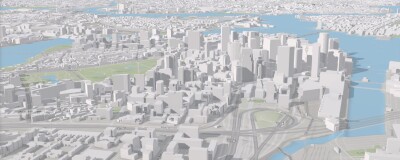The State of the Map Conference (SotM) is OpenStreetMap’s (OSM) mapping and developing community event. This year's European SoTM event offered an opportunity for this diverse group of individuals to meet and exchange knowledge, experiences, and plans for developing use and improvement of OSM. This article covers a presentation focused on the reason for founding Overture, its goals, and the case for collaboration between Overture and OSM to expand the availability and use of open map data. A video of the presentation can be found here, along with other videos of the event.
Presenter Marc Prioleau, Overture's Executive Director, has an extensive background in the mapping industry. For example, he worked for Meta, one of the founding companies of the Overture Maps Foundation (Overture) that is now about a year in existence. Overture was founded by Meta, Amazon Web Services, Microsoft, and TomTom as a collaborative effort to develop interoperable open map data as a shared asset that can strengthen mapping services worldwide.
More specifically, Overture wants to provide mapping data for software developers who build map services or use geospatial data. Because developers who work with mapping data are not necessarily mapping experts, a lot of the complexity that comes with mapping data can taken care of by Overture so that developers can start building mapping applications without having to do with things such as metadata, data preparation or quality testing.
Mapping data requirements for building mapping apps have changed significantly in the geospatial industry over the years. Today, developers want high-quality data from multiple providers to build the product they need, while a high-quality data standard improves the functionality of a map. However, for that to happen the data needs to be well-structured and easy to implement.
To meet these data requirements from developers, Overture defined three components to include in an open mapping data package for developers. First, they want to use the best sources of map data, including crowdsourced, government and AI generated data. Second, that data needs to have market-grade quality and validation to make sure it works well. Finally, developers want the data to come out in a schema that they know is stable and consistent they can build to. At this point in time, Overture has started to release data that is built into a set of six different themes, including Transportation, Places, Buildings, Administrative Boundaries, and Addresses.
The second part of the presentation focused on possible forms of collaboration between OSM and Overture. Prioleau stated he didn’t think Overture was competitive to OSM, as competition assumes scarcity. With no lack of data to be mapped, resources to do so and financial resources to fund both initiatives, he sees no base for competition between Overture and OSM. The goal of a possible collaboration would be to build more high-quality open data that is used by lots of people. With a growing demand for high-quality map data, this is a big challenge, while the timeliness and demands for accuracy, precision and attribution all contribute to a growth in the need for better mapping data.
Prioleau sees different areas for collaboration between Overture and OSM. While OSM and Overture have different perspectives and priorities, these make for a much richer map. Also, mapping things because the OSM community thinks they’re relevant can become useful to others in the future. He also made a point for Overture being able to increase the usage of open maps in more applications and devices. This in turn will create feedback loops for crowdsourced initiatives to keep a map up-to-date and high-quality, which will eventually lead to more usage of those maps.
In the Q&A session after the presentation, Prioleau was asked if he thought Overture would disrupt organizations that form part of the OSM ecosystem and add value to raw OSM data for example by aggregating data, normalizing it and providing services on top of it. While he expects some disruption as a result of Overture, he also noted the initiative would solve a broader problem, as not every single software company has a map data team to provide these services for developers. Overture will be able to do map data formatting and QA checks only once for the entire market, instead of many companies doing this individually for internal usage only.






